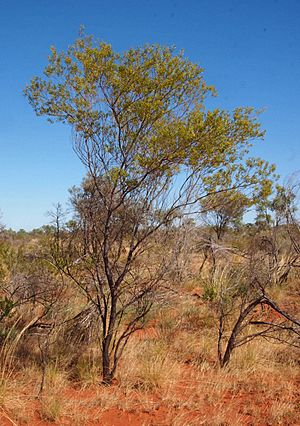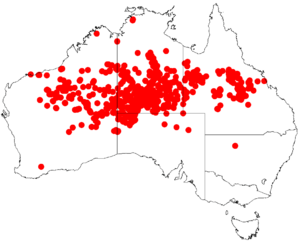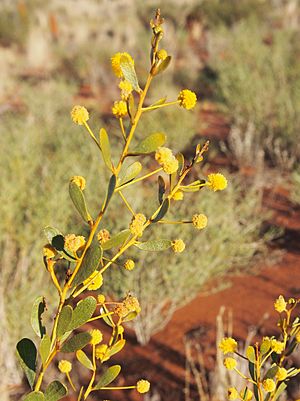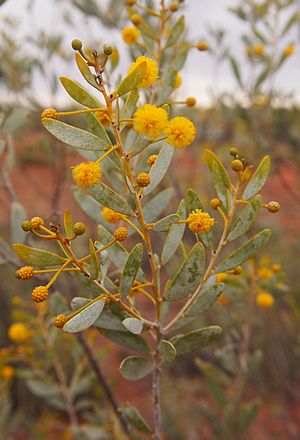Scented wax wattle facts for kids
Quick facts for kids Scented wax wattle |
|
|---|---|
 |
|
| A. melleodora habit | |
| Scientific classification | |
| Genus: |
Acacia
|
| Species: |
melleodora
|
 |
|
| Occurrence data from AVH | |
Acacia melleodora, also known as scented wax wattle, waxy wattle, honey wattle, or honey scented wattle, is a type of bush. It belongs to the Acacia plant family. This plant grows naturally in the dry, central parts of Australia.
Different Aboriginal language groups have their own names for this plant. In the Alyawarr language, it is called alhanker or alhepalh. In Anmatyerr, it is known as lkwernarr or partwert. The Kaytetye people call it alhepalhe, patwerte, or rewelarre. In Pitjantjatjara, it is mintju or ngarlklya. Finally, in Warlpiri, it is called matutu, marlarntarrpa, patutu, pilpirrinpa, or wurpardi.
Contents
What it Looks Like
This bush usually grows to be about 1 to 4 meters (3 to 13 feet) tall. It can be V-shaped or rounded. Its main stems grow from the ground and spread out. The older stems have rough, dark grey bark, while younger parts are smooth and light grey.
Its stiff, grey-green leaf-like parts are called phyllodes. They are about 3 to 4.5 centimeters (1 to 1.8 inches) long and 5 to 10 millimeters (0.2 to 0.4 inches) wide. These phyllodes are shaped like an oval or a narrow rectangle. They have two or three clear lines running along them.
Flowers and Seeds
The Acacia melleodora produces yellow flowers from May to September. These flowers grow in round, golden clusters. Each cluster is about 5 to 8 millimeters (0.2 to 0.3 inches) wide and holds 30 to 40 tiny flowers. A cool fact is that these flowers smell like honey!
After the flowers bloom, brown, narrow seed pods appear. These pods can be up to 9 centimeters (3.5 inches) long and 1.5 centimeters (0.6 inches) wide. Inside, they hold dark brown, oval-shaped seeds. The seeds are about 4 millimeters (0.16 inches) long.
Life Cycle
This wattle bush usually lives for 2 to 10 years. It starts making seeds when it is 1 to 3 years old. If there's a bushfire, the plant can grow back from its base. This is because it has a special woody lump underground called a lignotuber. This helps it survive fires.
Sometimes, the phyllodes of A. melleodora can look a lot like those of other wattle plants. These include Acacia montana, Acacia praemorsa, and sometimes Acacia johnsonii.
How it is Named
The way scientists name and classify living things is called taxonomy. The Acacia melleodora was first officially described by a scientist named Leslie Pedley in 1897.
The name melleodora comes from two Greek words. Meli means "honey," and odor means "smell." This name was chosen because the flowers have a strong, sweet honey scent.
This plant is closely related to other wattle species. These include Acacia dictyophleba, Acacia jensenii, and Acacia sabulosa.
Where it Grows
The scented wax wattle grows in many parts of Australia. You can find it in the southern and central areas of the Northern Territory. It also grows in the northwestern part of South Australia, central Queensland, and the Kimberley, Pilbara, and Goldfields regions of Western Australia.
It likes to grow on sand dunes and sandy plains. It can also be found in shallow, stony, or red sandy soils, often near laterite (a type of soil). You will usually see it growing in open forests with Eucalypt trees or among spinifex grasses.
Uses of the Plant
You can buy this plant as young seedlings or as seeds. If you plant the seeds, you need to soak them in hot water first. This helps them sprout.
Aboriginal people have used this bush for many things. They used it to make toys, traps, weapons, and other tools. The seeds and the fleshy part of the fruit were eaten as food. They also used the roots as a source of water.



